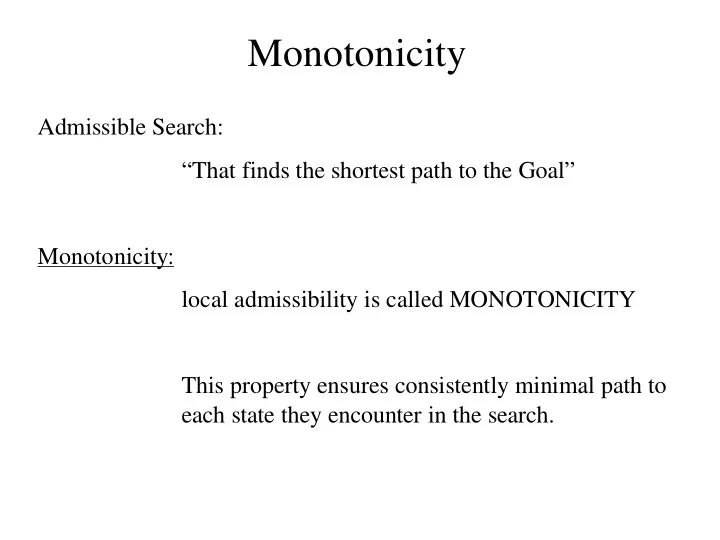

Monotonicity Admissible Search: “That finds the shortest path to the Goal” Monotonicity: local admissibility is called MONOTONICITY This property ensures consistently minimal path to each state they encounter in the search.
366 It takes accumulative effect into consideration (for a distance problem) 390 Along any path from the root, the cost never decreases (If this is true then the Heuristic 526 417 is Monotonic in nature.) n f(n) = g(n) + h(n) = 3 + 4 = 7 f’ (n) = g' (n’) + h' (n’) = 4 + 2 = 6 n’
Non-Monotonic Monotonic If f(n`) < f(n) (Non - Monotonic) Then f(n`) = max (f(n), g(n`) + h(n`)) “We take the cost of parent Node”. Pathmax. This when only heuristic cost is taken Another representation = h(n) - h(n`) <= cost (n, n`)
Informedness. For two A “heuristic h 1 and h 2 if h 1 (n) <= h 2 (n) for all states ‘n’ in the search space, heuristic h 2 is said to be “more informed” than h 1 . Both h 1 and h 2 can give OPTIMAL path but h 2 examines very few states in the process.
Monotonic Heuristics are Admissible States = S 1 , S 2 , …, S g S 1 = Start S g = goal h(s 1 ) - h(s 2 ) <= cost (s 1 , s 2 ) h(s 2 ) - h(s 3 ) <= cost (s 2 , s 3 ) h (g-1) - h (g) <= cost (S g-1 , S g ) ADD h (s1) - h (g) <= cost (S 1 , S g )
h (n) = 0 Uninformed search Example Breadth - First search A * is more informed then Breadth - first search
Adversary Search (Games) AIM: The aim is to move in such a way as to ‘stop’ the opponent from making a good / winning move. Game playing can use Tree - Search. The tree or game - tree alternates between two players.
Things to Remember: 1. Every move is vital 2. The opponent could win at the next move or subsequent moves. 3. Keep track of the safest moves 4. The opponent is well - informed 5. How the opponent is likely to response to your moves.
Two move win A P1 moves D B Player 1 = P 1 C Player 2 = P 2 P2 moves E F G H I J wins P1 P2 P1 P1 P2 P2 Safest move for P 1 is always A C D (if allowed 1 st move) Safest move for P 2 is always A
Minimax Procedure for Games Assumption: Opponent has same knowledge of state space and make a consistent effort to WIN. MIN: Label for the opponent trying to minimize other player’s (MAX) score. MAX: Player trying to win (maximise advantage) Both MAX and MIN are equally informed
Rules 1. Label level’s MAX and MIN 2. Assign values to leaf nodes: 0 if MIN wins 1 if MAX wins 3. Propagate values up the graph. If parent is MAX, assign it Max-value of its children If parent is MIN, assign it min-value of its children
Minimaxing to fixed to play depth (Complex games) Strategy: n - move look ahead - Suppose you start in the middle of the game. - One cannot assign WIN/LOOSE values at that stage - In this case some heuristics evaluation is applied - values are then projected back to supply indicate WINNING/LOOSING trend.
Summary • Assign heuristic values to leaves of n-level graph • Propagate value to root node • This value indicates best state that can be reached in ‘n’ moves from this start - state or node MAXIMIZE for MAX Parents MINIMIZE for MIN parents
Example: TIC - TAC - TOE X X O O X O M(n) = Total of my possible winning lines O(n) = Trial of Opponents E(n) = M(n) - O(n) winning lines
Horizon Effect • Heuristics applied with limited ahead may lead to a bad situation and the person may leave the game. • Same depth in search can be added to partially reduce this affect.
Alpha - Beta Procedures • Minimax procedure pursues all branches in the space. Same of them could have been ignored or pruned. • To improve efficiency pruning is applied to two person games
Simple Idea if A > 5 or B < 0 If A >5 and B <0 If the first condition If the first condition A > 5 succeeds then failed then evaluating B < 0 may not be evaluated. B < 0 is unnecessary.
a MAX c MIN b = 0.4 -0.2 e MAX d = 0.6 -0.2 MIN f = -0.5 g = -0.2 - MAX can score maximum of -0.2 when moves a - c - e. MAX has a batter option to move to ‘b’
- MAX node neglects MAX values <= a (atleast it A can score) at MIN nodes below it. - MIN node neglects C values >= b (almost it MIN can score) at MAX B =10 nodes below it G=0 H C node can score ATMOST 0 nothing above 0 (beta) A node can score ATLEAST 10 nothing less than 10 (alpha)
Complexity Reduction Complexity Cost: “Can be estimated roughly through measuring the size of open and closed list.” (A) Beam Search: “In beam search only the ‘n’ most pronishing state are best for future “Bound applied consideration” to the open list.” - The procedure may miss the solution by pruning it too early.
More Informed ness (B) - Apply more informed heuristics to reduce the complexity. - This may increase the computational cost in computing the heuristic
Recommend
More recommend